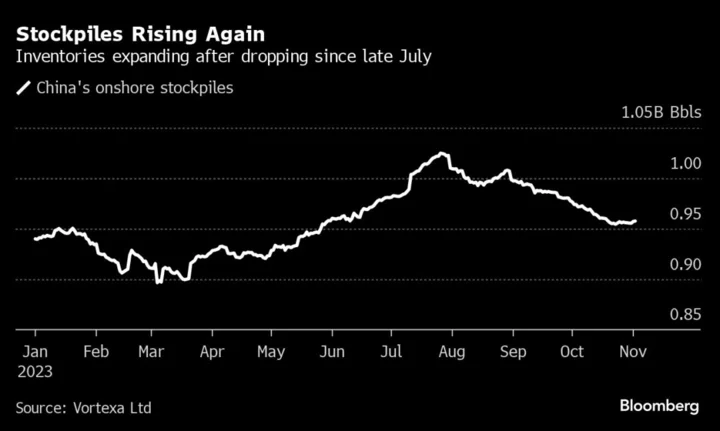The oil demand outlook in China, the world’s biggest importer, isn’t offering much inspiration to bulls as the end of the year approaches.
Refining margins are falling, crude and fuel stockpiles are building and a hoped-for sharp jump in air travel still hasn’t eventuated. That’s mirroring the situation in the wider economy, where business and consumer confidence remain low despite government efforts to juice growth.
“Domestic demand has lost steam following the Golden Week holiday in October, and we don’t see any major supporting factors through winter,” said Mia Geng, an analyst at FGE. Gasoline and diesel consumption typically drop in the last couple of months of the year, and there could be additional downside risk as revenge travel seems to be wearing off in China, she said.
China’s crude imports did manage to increase by 7% in October from the previous month, customs data showed on Tuesday, but that came after a 13% drop in September.
These five charts give a more detailed look at the demand picture in Asia’s biggest economy:
Negative Margins
Higher crude prices and weakening demand for diesel and gasoline have hit profitability at China’s independent refiners over the past couple of months. Margins at the plants known as teapots, which account for about a quarter of the country’s processing capacity, turned negative in late October for the first time since early January, according to local industry consultant JLC. Run rates at facilities in Shandong province, where most of the teapots are located, were around 57% of capacity in the week through Nov. 3, the lowest since May 2022, OilChem data show.
Stockpiles Stop Shrinking
After falling by about 70 million barrels from late July through late-October, China’s onshore crude stockpiles are ticking up again in a sign domestic consumption is flagging, according to data from Vortexa Ltd. They’ve edged higher, albeit modestly, over the last two-and-a-half weeks. However, elevated oil prices will probably limit Chinese purchases for stock-building and the nation will likely draw down inventories, meaning crude imports would “stay more moderate,” Citigroup Inc. said in a note late last month.
Take-Off Delayed
An increase in air travel and jet fuel demand over the Golden Week holidays in early October wasn’t as strong as had been hoped for, evidence that people are reluctant to spend too much on vacations while economic conditions are so uncertain. International flights from China have been particularly slow to recover. Chinese jet fuel consumption is likely to rise gradually through early January, but there won’t be a significant uptick until the start of the second quarter, according to a forecast from BloombergNEF.
Falling Exports
China’s oil-product exports will plunge by 40% in November from October, according to OilChem. Refiners have already used up most of their fuel export quotas for 2023, and the government told them in late September not to expect any more this year. That will likely lead to a major drop in diesel shipments, which account for most of the country’s overseas fuel sales, in the last couple of months of the year.
Gasoline Backlog
China’s commercial gasoline inventories rose in the three weeks through Oct. 26, while run rates at state-owned refiners have fallen, OilChem data show. The high stockpiles and a lack of export quota are likely to lead to more declines in activity at processors, the industry consultant said. Chinese gasoline demand will peak this year due to the rapid adoption of electric vehicles, oil major Sinopec predicted in August.
The Week’s Diary
(All times Beijing unless noted.)
Wednesday, Nov. 8:
- China International Import Expo in Shanghai
- China International Oil and Gas Trade Congress
- CCTD’s weekly online briefing on Chinese coal, 15:00
- China Carbon Market Conference in Shanghai
Thursday, Nov. 9:
- China International Import Expo in Shanghai
- China International Oil and Gas Trade Congress
- China’s inflation data for October, 09:30
- China to release October aggregate financing & money supply by Nov. 15
- China’s monthly CASDE crop supply-demand report
Friday, Nov. 10:
- China International Import Expo in Shanghai
- China weekly iron ore port stockpiles
- Shanghai exchange weekly commodities inventory, ~15:30
On the Wire
Iron ore has reached “unreasonable” levels that are hurting Chinese steel mills, according to China Mineral Resources Group, the state-backed firm trying to boost Beijing’s sway over prices.
The US Treasury reiterated its call for greater transparency in how Beijing conducts its exchange-rate policy and said it was monitoring China alongside five other major trading partners over its currency practices.
At the peak of China’s property bubble in 2018, the sector accounted for slightly more than 24% of GDP. Its share has since dropped to less than 20% — and is still falling, says Bloomberg Economics.

